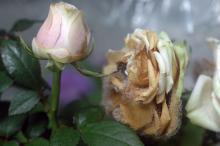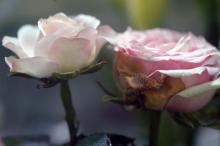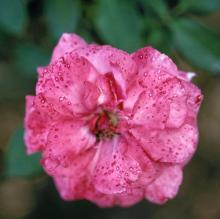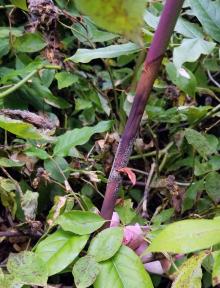See:
Greenhouse Plants, Ornamental - Gray Mold
Cause Botrytis cinerea, a fungus that is ubiquitous and survives well as a saprophyte on dead plant debris as mycelium or sclerotia. Conidia from these sources or from active infections initiate infections. Common entry points include pruning wounds including those from normal winter pruning and removing spent flowers. Buds, flowers, leaves, and stems can be infected directly when the fungus produces enzymes that degrade components of the cuticle. Healthy tissue can become infected through weakened or dead tissues that are colonized by the fungus. It may also be a secondary invader attacking plants already infected with another pathogen.
A moist, humid environment is ideal for pathogen sporulation and spread. Spore dispersal is stimulated by changes in relative humidity. Concentrations peak in the greenhouse during irrigating, spraying pesticides, harvest, and shipping. Often the infection is imperceptible when cutting and packing flowers, however, moist conditions that occur during transport and/or storage favor disease development. Frost and cold injury to canes and buds contributes to disease development.
Bareroot nursery stock held in moist, cold storage conditions also can develop Botrytis blight on canes and roots.
Symptoms Infected buds may fail to open, droop, and develop smooth, slightly sunken, grayish-black lesions. A grayish-brown mycelial growth may develop on the entire bud and extend into the stem. Petal tips may become brown; or numerous small flecks, circular brown spots, or blister-like patches may appear on petals. Infected stubs or pruning wounds will develop into cane blights or cankers. Canes may be girdled, causing stem collapse.
Cultural control
- Collect and destroy infected plant debris and tissues from and around the plant.
- Maintain a steady, relatively dry environment by keeping greenhouse humidity below 90%, increasing spacing between plants for good air circulation, and taking care not to splash water on foliage during watering. Heating the greenhouse at night (especially for zero or negative DIF) or venting around sunset may be necessary. Heating in the morning before sunup can also help prevent dew formation as air temperature increases faster than the temperature of plant parts. If using DROP or DIP for size control, do not let humidity rise above 90%.
- Space plants for adequate air movement.
- Use drip rather than overhead irrigation.
- Use calcium nitrate, gypsum, or similar calcium source topdressed or incorporated into container media.
Chemical control Use as a foliar spray, but focus on cultural controls. Resistance to FRAC groups 1, 2, 7 and 9 have been detected in cut roses coming in from out of the country. Alternate or tank-mix materials with different modes of action to prevent developing resistant fungal populations. Good to mix or alternate with FRAC group M3 or M5 fungicides.
Products available in home packaging: None are currently registered.
Products available for commercial use:
- Astun at 10 to 17 fl oz/100 gal water. Group 7 fungicide. 12-hr reentry.
- Broadform at 4 to 8 fl oz/100 gal water. Group 7 + 11 fungicide. 12-hr reentry.
- Captan 80 WDG at 1.5 lb/100 gal water. Group M4 fungicide. 48-hr reentry.
- Chipco 26019 FLO at 1 to 2.5 quarts/100 gal water. Group 2 fungicide. 12-hr reentry.
- Daconil Weather Stik at 1 pint/100 gal water. 12-hr reentry. 'Knock Out' and 'Double Delight' roses can be sensitive resulting in damaged foliage. Group M5 fungicide.
- Decree 50 WDG at 0.75 to 1.5 lb/100 gal water. Group 17 fungicide. 12-hr reentry.
- Mancozeb-based products can be used as mixing partners and provide some protection. Group M3 fungicides. 24-hr reentry.
- Fore 80 WP at 1.5 lb/100 gal water plus a spreader-sticker.
- Protect DF at 1 to 2 lb/100 gal water plus 2 to 4 oz spreader-sticker.
- Medallion WDG at 2 to 4 oz/100 gal water. Using with oils or adjuvants may damage plant. Group 12 fungicide. 12-hr reentry.
- Pageant at 12 to 18 oz/100 gal water. Do not use with organosilicone-based adjuvants. Group 7 + 11 fungicide. 12-hr reentry.
- Palladium at 4 to 6 oz/100 gal water. Avoid excessive runoff to small plants, which may result in stunting and/or chlorosis. Group 9 + 12 fungicide. 12-hr reentry.
- Regime at 20.5 to 45.7 fl oz/A. Reapply if rain occurs within 12 hours of original application. Group BM01 fungicide. 4-hr reentry.
- Sil-Matrix at 1 to 4 quarts/100 gal water plus a nonionic surfactant. 4-hr reentry. O
- Spectro 90 WDG at 1.53 lb/A. Group 1 + M5 fungicide. 12-hr reentry.
- Spirato GHN at 2 to 4 fl oz/100 gal water. Use with oils or adjuvants may cause plant damage. Group 12 fungicide. 12-hr reentry.
- Terraguard SC at 4 to 8 fl oz/100 gal water. Group 3 fungicide. 12-hr reentry.
- Thiophanate-methyl-based products. Group 1 fungicide. 12-hr reentry.
- Cleary's 3336 EG at 12 to 16 oz/100 gal water.
- OHP 6672 4.5 F at 10 to 14.5 fl oz/100 gal water.
Reference Muñoz, M., Faust, J.E., and Schnabel, G. 2019. Characterization of Botrytis cinerea From Commercial Cut Flower Roses. Plant Disease 103:1577-1583.






